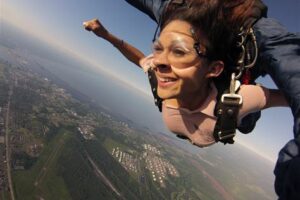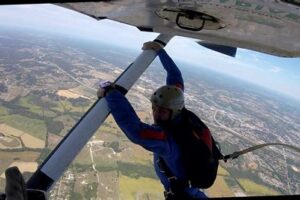Table of Contents
Learn how to skydive solo with our comprehensive guide. Discover the essential skills, techniques, and safety measures needed to jump from a plane on your own. From proper parachute packing to body positioning during freefall, we’ll walk you through every step of the thrilling solo skydiving experience. Start your adventure today!
Are you ready to experience the ultimate thrill of skydiving? If you’ve always dreamed of soaring through the clouds and feeling the rush of adrenaline, then it’s time to learn how to skydive solo. Transitioning from tandem jumps to flying solo can be an exhilarating and empowering journey, allowing you to take full control of your own destiny in the vast expanse of the sky. Whether you’re a seasoned thrill-seeker or a first-time adventurer, this guide will provide you with the essential steps and expert tips to ensure a safe and unforgettable solo skydiving experience. So, fasten your seatbelt, put on your parachute, and get ready to embark on an extraordinary adventure that will leave you breathless and yearning for more.
Introduction
Skydiving is an exhilarating activity that allows you to experience the thrill of freefalling through the sky. While many people enjoy tandem skydiving, where they jump with an experienced instructor, others aspire to skydive solo. Skydiving solo requires proper training and certification to ensure safety. In this article, we will guide you through the steps of how to skydive solo like a professional.
Step 1: Find a Reputable Skydiving School
The first step in learning to skydive solo is to find a reputable skydiving school. Look for a school that is certified by a recognized organization, such as the United States Parachute Association (USPA). This ensures that the instructors and training programs meet high safety standards.
Step 2: Complete Ground Training
Before you can skydive solo, you must complete ground training. This training includes theoretical lessons on equipment, safety procedures, body positioning, emergency protocols, and landing techniques. Pay close attention during these classes, as they provide the foundation for your skydiving skills.
Step 3: Practice in a Wind Tunnel
Once you have completed ground training, it’s time to practice in a wind tunnel. A wind tunnel simulates the sensation of freefall, allowing you to practice body control and stability. This is a crucial step in becoming comfortable with the movements and positions necessary for a successful solo skydive.
Step 4: Accompany Experienced Skydivers
Before you can jump solo, you will need to gain experience by accompanying experienced skydivers. This allows you to observe their techniques, learn from their expertise, and become familiar with the skydiving environment. Look for opportunities to join group jumps or participate in mentorship programs offered by your skydiving school.
Step 5: Complete Tandem Jumps
In order to progress towards solo skydiving, you will need to complete a series of tandem jumps. Tandem jumps involve jumping with an instructor who will guide you through the process. These jumps help build your confidence, improve your body positioning, and allow you to experience the thrill of freefall.
Step 6: Pass the Accelerated Freefall Course
The next step in your solo skydiving journey is to pass the Accelerated Freefall (AFF) course. This course consists of several levels, each focusing on different aspects of skydiving. You will gradually transition from jumping with two instructors to jumping solo, demonstrating your skills and knowledge along the way.
Step 7: Obtain the Required Certifications
Once you have successfully completed the AFF course, you will need to obtain the necessary certifications to skydive solo. This typically includes a Class A license from the USPA or an equivalent organization in your country. These certifications indicate that you have met the required skill level and knowledge to jump without an instructor.
Step 8: Continue Learning and Practicing
Skydiving is a continuous learning process, even after obtaining your solo skydiving certification. Take advantage of advanced training programs offered by your skydiving school to further enhance your skills. Regularly practice your techniques, maintain physical fitness, and stay updated on safety procedures to ensure a safe and enjoyable skydiving experience.
Step 9: Join a Skydiving Community
Being part of a skydiving community is not only a great way to meet like-minded individuals but also provides opportunities for growth and knowledge sharing. Joining a community allows you to learn from experienced skydivers, participate in group jumps, and stay connected with the latest developments in the sport.
Step 10: Set Goals and Have Fun!
As a solo skydiver, it’s important to set personal goals and challenge yourself to achieve new heights in the sport. Whether it’s mastering advanced maneuvers, competing in skydiving events, or simply enjoying the freedom of flight, remember to have fun along the way. Skydiving is an incredible adventure, and as a professional solo skydiver, you have the opportunity to experience it to the fullest.
Conclusion
Skydiving solo requires dedication, training, and a commitment to safety. By following these steps, finding a reputable school, completing ground training, practicing in a wind tunnel, gaining experience through tandem jumps, passing the AFF course, obtaining certifications, and continuing to learn and practice, you can become a professional solo skydiver. So, gear up, take the leap, and enjoy the incredible experience of skydiving solo!
How to Skydive Solo: A Comprehensive Guide
Skydiving is an exhilarating and unforgettable experience that allows individuals to defy gravity and experience the thrill of freefall. Although most people start their skydiving journey with tandem jumps, some aspire to take it to the next level – solo jumps. Skydiving solo demands extensive knowledge, skills, and utmost precision to ensure a safe and memorable experience. In this guide, we will provide you with eight essential subheadings that will serve as a roadmap for your quest to master solo skydiving.
1. Obtain Proper Training and Certification:
Before embarking on your solo skydiving journey, it is crucial to enroll in a certified skydiving training program. These comprehensive courses, often available at skydiving centers, are designed to teach you the necessary skills, safety protocols, and techniques required for solo jumps. Completing the training will culminate in obtaining your skydiving license, certifying you to jump solo.
2. Understand the Equipment:
One of the crucial aspects of skydiving solo is having a thorough understanding of the equipment used. Learn the different components of a skydiving rig, including the parachute system, harness, container, and reserve chute. Ensure you can confidently inspect and safely use all the equipment to prevent any potential malfunctions during your solo jumps.
3. Master Body Positioning:
Achieving the proper body position during freefall is vital for stability and control during your solo jumps. Focus on maintaining a stable arch body position to minimize any unnecessary movements that can impact your stability. Practice this fundamental skill during your training sessions to build muscle memory, allowing for optimized control during your solo jumps.
4. Plan and Execute Emergency Procedures:
When skydiving solo, it is crucial to develop a clear understanding of emergency procedures and how to handle unexpected situations. Learn how to manage potentially hazardous scenarios such as a malfunctioning parachute or loss of altitude awareness. Practice these emergency procedures regularly during training to ensure you react calmly and efficiently during your solo jumps.
5. Practice Effective Canopy Control:
Mastering canopy control is essential for safe solo skydiving. Gain a deep understanding of how to steer and navigate your parachute using the toggles and rear risers. Learn how to land safely by gauging wind conditions, planning your descent path, and executing a proper flare before touchdown. Regular practice and continuing education on canopy control will enhance your confidence and safety in the skies.
6. Develop Weather Awareness:
When skydiving solo, it becomes vital to possess weather awareness skills. Understand how different weather conditions can impact your jumps and recognize signs of unfavorable weather, such as strong winds, gusts, or storms. Continuously monitor weather forecasts, consult with experienced skydivers and instructors, and know when to postpone or cancel a jump due to adverse conditions.
7. Communicate Effectively with Others:
Solo skydiving does not mean isolation; engaging with fellow skydivers and maintaining clear communication is crucial for a safe experience. Familiarize yourself with the common hand signals and radio communications used during jumps and practice effective communication techniques during group jumps. Always adhere to designated landing patterns and follow the instructions provided by the drop zone authorities.
8. Continue Learning and Progression:
Even after obtaining your skydiving license, the learning journey never ends. Seek opportunities to further enhance your skills and knowledge through advanced training courses, seminars, and workshops. Surround yourself with seasoned skydivers who can provide valuable advice and mentorship, as this will accelerate your progression and help you become a confident and experienced solo skydiver.
Conclusion:
Embarking on the journey of skydiving solo requires dedication, training, and a deep understanding of the sport. By following these eight subheadings, you will be equipped with the necessary tools to ensure a safe, thrilling, and unforgettable experience throughout your solo skydiving journey. Remember to always prioritize safety, stay disciplined in your training, and never stop learning to excel in the world of solo skydiving.
How to Skydive Solo: A Professional Guide
In this comprehensive guide, we will outline the necessary steps and precautions for skydiving solo. With a focus on safety and technique, we aim to equip you with the knowledge and skills required to successfully execute a solo skydive. Whether you are an experienced skydiver looking to take the next step or a beginner seeking an exhilarating adventure, this guide is tailored to meet your needs.
Important Considerations:
- Physical Fitness: Prior to attempting a solo skydive, it is crucial to ensure that you are in good physical condition. Regular exercise, adequate sleep, and a healthy diet will contribute to your overall fitness level.
- Training: Enrolling in a reputable skydiving school is essential for acquiring the necessary skills and knowledge to skydive solo. Qualified instructors will guide you through ground training sessions, covering topics such as body positioning, canopy control, emergency procedures, and more.
- Equipment: Understanding and properly using skydiving equipment is vital for your safety. Familiarize yourself with the various components, including the harness, altimeter, parachute, and reserve system. Regularly inspect your gear and consult professionals for maintenance and repairs.
- Weather Conditions: Always check weather conditions before planning a solo skydive. Strong winds, rain, fog, or thunderstorms can pose significant risks. Consult with local experts or instructors to ensure optimal conditions for safe skydiving.
The Solo Skydiving Process:
- Preparation: Prepare yourself mentally and physically for the jump. Review your training materials, perform necessary equipment checks, and go through pre-jump procedures.
- Exit and Freefall: Once in the aircraft, position yourself correctly near the exit. Follow instructions from your instructor or jumpmaster and execute a controlled exit. Maintain a stable body position during freefall, focusing on maintaining altitude awareness and stability.
- Canopy Deployment: At the designated altitude, deploy your parachute using the appropriate technique taught during training. Ensure proper canopy inflation and control before proceeding to the next step.
- Canopy Flight: Maintain control of your canopy by utilizing steering toggles or handles. Practice turns, stalls, and basic maneuvers while maintaining situational awareness and observing other skydivers in the vicinity.
- Landing: Approach the landing area with caution, considering wind direction and speed. Execute a flare maneuver at the appropriate height to slow your descent and ensure a safe landing. Practice landing techniques under the supervision of an instructor to enhance your skills.
Continued Learning and Progression:
Skydiving is a continual learning experience, and skydivers should constantly seek opportunities to enhance their skills and knowledge. Consider joining a skydiving community or club to connect with experienced skydivers who can provide guidance and share valuable insights. Participate in advanced training courses to expand your capabilities and explore different disciplines within the sport.
Conclusion:
Undertaking a solo skydive requires careful preparation, thorough training, and adherence to safety guidelines. By following these steps and consulting with professionals, you can embark on an incredible journey of personal growth, exhilaration, and excitement. Remember, safety should always be the top priority, and continuous learning will contribute to a rewarding skydiving experience. Enjoy the thrill of solo skydiving while embracing the freedom and beauty of the skies!
Dear blog visitors,
Thank you for taking the time to read our article on how to skydive solo. We hope that you have found the information provided to be both informative and helpful. Skydiving can be an exhilarating and life-changing experience, and learning to do it solo is a significant milestone in any skydiver’s journey. In this closing message, we would like to summarize the key points discussed in the article and offer some final words of advice.
In the first paragraph of our article, we emphasized the importance of proper training and preparation before attempting to skydive solo. Skydiving is an extreme sport that carries inherent risks, and it is crucial to approach it with the utmost seriousness and respect. We recommend enrolling in a reputable skydiving school that offers comprehensive training programs. These programs typically include classroom instruction, simulator practice, and tandem jumps with an experienced instructor. Gradually, as you gain confidence and demonstrate proficiency, you will progress to jumping solo under the close supervision of your instructors.
The second paragraph focused on the essential skills and techniques required to skydive solo. We discussed the importance of mastering body control, maintaining stability in freefall, and executing a proper parachute deployment. Transitioning from tandem jumps to solo jumps involves learning to manipulate your body position, recognize and correct instability, and deploy your parachute at the right altitude. These skills are honed through repeated practice, and it is crucial to listen to the guidance of your instructors and follow their instructions diligently. Remember, safety should always be your top priority when skydiving.
Lastly, in the final paragraph, we highlighted the significance of mental preparation and maintaining a calm mindset while skydiving solo. Jumping out of an airplane alone can be an intense and nerve-wracking experience, especially for beginners. It is normal to feel a mix of excitement and anxiety before your first solo jump. However, by staying focused, trusting in your training, and controlling your emotions, you can overcome any fears and enjoy the thrill of skydiving to the fullest. Remember, skydiving solo is not just about the physical act of jumping; it is also about conquering your fears and pushing your personal boundaries.
We hope that this article has provided you with valuable insights into the process of learning to skydive solo. Always remember to prioritize safety, seek proper training, and stay calm during your jumps. Skydiving can be a life-changing experience that offers a unique perspective on the world and yourself. We wish you all the best on your skydiving journey, and may you have many safe and memorable solo jumps in the future!
Happy skydiving!
Video How To Skydive Solo
People Also Ask About How To Skydive Solo
1. Is it possible to learn how to skydive solo?
Yes, it is absolutely possible to learn how to skydive solo. Many professional skydiving schools offer comprehensive training programs that guide individuals through the process of becoming a certified solo skydiver. These programs typically include ground instruction, tandem jumps, and progressive levels of training jumps under the supervision of experienced instructors.
2. What are the prerequisites for learning to skydive solo?
Each skydiving school may have slightly different prerequisites, but generally, you must be at least 18 years old, in good physical health, and weigh within certain limits to ensure safety during the jumps. Additionally, some schools may require you to complete a tandem jump before starting the solo training program.
3. How long does it take to become a certified solo skydiver?
The duration of the training program can vary depending on the individual’s progress and the specific requirements of the skydiving school. However, most programs aim to equip students with the necessary skills and knowledge to jump solo within 25-30 jumps. This typically spans over several days or weeks, depending on the student’s availability and commitment to the training.
4. What kind of training is involved in becoming a solo skydiver?
Becoming a solo skydiver involves a combination of theoretical classroom training and practical jumps. The training covers various aspects such as body position, parachute deployment, emergency procedures, altitude awareness, and landing techniques. Instructors will closely supervise each jump, gradually allowing students to perform more tasks independently as they progress through the training program.
5. How safe is skydiving solo?
Skydiving solo can be safe when proper training, equipment, and procedures are followed. The training provided by certified skydiving schools focuses on teaching students the necessary skills to handle various situations and minimize risks. Additionally, all solo jumps require the use of properly maintained equipment, including a reliable parachute system and an automatic activation device for added safety.
6. Can I go skydiving solo after completing the training program?
Upon successful completion of the required training program, you should be able to obtain your solo skydiving certification. This certification allows you to jump solo at licensed drop zones. However, it is important to note that continuous practice, ongoing learning, and adherence to safety guidelines are crucial to maintaining proficiency and ensuring a safe skydiving experience.
7. Are there any age restrictions for learning to skydive solo?
The minimum age requirement for learning to skydive solo is typically 18 years old. This is to ensure maturity, decision-making ability, and physical readiness to handle the demands of skydiving. However, some skydiving schools may offer specialized programs for younger individuals, such as tandem jumps with instructors or static-line jumps with additional precautions.






